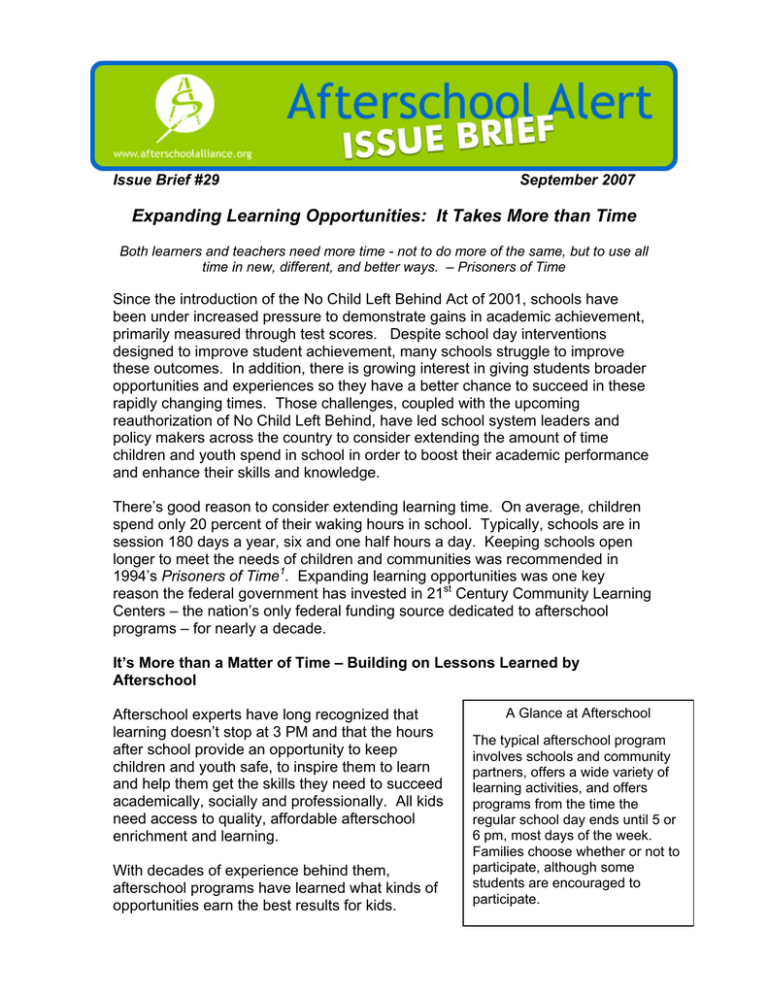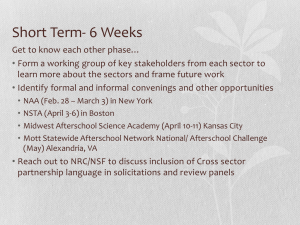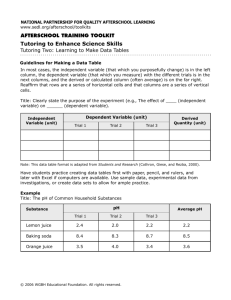Expanding Learning Opportunities: It Takes
advertisement

Issue Brief #29 September 2007 Expanding Learning Opportunities: It Takes More than Time Both learners and teachers need more time - not to do more of the same, but to use all time in new, different, and better ways. – Prisoners of Time Since the introduction of the No Child Left Behind Act of 2001, schools have been under increased pressure to demonstrate gains in academic achievement, primarily measured through test scores. Despite school day interventions designed to improve student achievement, many schools struggle to improve these outcomes. In addition, there is growing interest in giving students broader opportunities and experiences so they have a better chance to succeed in these rapidly changing times. Those challenges, coupled with the upcoming reauthorization of No Child Left Behind, have led school system leaders and policy makers across the country to consider extending the amount of time children and youth spend in school in order to boost their academic performance and enhance their skills and knowledge. There’s good reason to consider extending learning time. On average, children spend only 20 percent of their waking hours in school. Typically, schools are in session 180 days a year, six and one half hours a day. Keeping schools open longer to meet the needs of children and communities was recommended in 1994’s Prisoners of Time1. Expanding learning opportunities was one key reason the federal government has invested in 21st Century Community Learning Centers – the nation’s only federal funding source dedicated to afterschool programs – for nearly a decade. It’s More than a Matter of Time – Building on Lessons Learned by Afterschool Afterschool experts have long recognized that learning doesn’t stop at 3 PM and that the hours after school provide an opportunity to keep children and youth safe, to inspire them to learn and help them get the skills they need to succeed academically, socially and professionally. All kids need access to quality, affordable afterschool enrichment and learning. With decades of experience behind them, afterschool programs have learned what kinds of opportunities earn the best results for kids. A Glance at Afterschool The typical afterschool program involves schools and community partners, offers a wide variety of learning activities, and offers programs from the time the regular school day ends until 5 or 6 pm, most days of the week. Families choose whether or not to participate, although some students are encouraged to participate. Content matters. School-community partnerships matter. It’s not just extending time, but providing quality, engaging, enriching learning opportunities during that time. Afterschool programs are successfully expanding learning by making good use of extended time to offer new and different ways of learning. In January 2007, the Time, Learning and Afterschool Taskforce released A New Day for Learning. Funded by the C.S. Mott Foundation, this groundbreaking report asks for a fundamental change in how children use their time for learning. A New Day for Learning proposes that the afterschool approach to learning is necessary to the success of any effort to expand learning opportunities. The proven afterschool approach to learning embraces the following practices: • • • • • • • Academic instruction is designed to meet the needs, abilities and learning styles of students and provide them with a better chance to succeed; Engaging, relevant activities are often project-based, community-based or both, and designed to increase student motivation to learn; Linkages are made to the school day, but content is delivered in different ways by applying school day lessons to real world settings; Student choice is built into program design; Partnerships among schools and community-based organizations are essential because they bring new and diverse learning opportunities; Students have opportunities to work both independently and in groups, and to play leadership roles; and Communication between families and school-day staff is ongoing. The afterschool approach builds on the school day experiences of youth, but does not mirror it. In addition to boosting in-school success, afterschool programs contribute to the development of work-ready skills such as team work, problem-solving, critical thinking, oral communication, civic engagement, conflict resolution, healthy decision making and more. A growing body of evidence shows that the afterschool approach to learning works. Afterschool programs, even those not explicitly aimed at improving academic achievement, are linked to in-school gains. Studies also show measurable improvements in students’ social behavior. Many credit these advances to the fact that afterschool programs have discovered how to effectively engage youth in learning. Research shows: • • • Merely adding more of the same to the school day will not improve student outcomes. In fact, ‘more of the same’ is likely to further disengage kids who are most at-risk of dropping out of school.2 The Collaborative for Academic, Social, and Emotional Learning reviewed data from 73 afterschool studies and concluded that afterschool programs employing evidence-based approaches to improving students' personal and social skills consistently showed multiple benefits, including improvements in children's personal, social and academic skills, as well as their self-esteem.3 Afterschool programs give students opportunities to explore interests, learn real world skills, solve problems, develop leadership and teamwork skills, connect • • with adult role models, and become involved in improving their communities.4 It is these skills that business leaders cite as most needed in today’s workforce. In a recent survey, employers reported that four of the five of the most important skills needed by high school graduates are applied thinking and personal skills rather than basic skills – professionalism, teamwork, oral communication, and ethics and social responsibility.5 New “science of learning” research has changed our understanding of how children learn, and underscores the limited value of rigid drill and practice. It is now known that the learning that takes place beyond the traditional classroom lessons affects students’ achievement in important ways.6 Providing students with a variety of activities, a choice of interests and time to delve into projects -- practices long embraced by afterschool -- keeps children motivated, engaged, and interested in learning. 7 Research shows that high-quality afterschool programs provide kids time to learn in multiple ways, through all sorts of activities that are often unavailable during the traditional school day…The afterschool approach to less formal, hands-on learning must be in the daily mix. -- Lucy Friedman, The After-School Corporation Extended Day Schools - The Next Big Idea? Recently, policy makers, the media and think-tanks have been considering extended day schools as the latest solution to providing more time for learning. A variety of proposals have been offered, from simply adding more classroom time to using additional hours to engage students in less traditional, hands-on enrichment activities. Models draw on KIPP academies, other charter schools and some public and private schools that extend the school day. The following extended day initiatives have recently been proposed or implemented: • • • • • Massachusetts is funding a $13 million publicA Glance at Extended Day Schools private partnership to lengthen the school day. Ten middle schools have already Extended day schools are, at their core, a received funding to add at least 300 hours to school reform model. In Massachusetts, the current school schedule. The extra time the only state thus far to implement is used for a mix of additional classroom time extended day, most schools extend the plus enrichment activities and includes day by approximately one hour and collaboration with afterschool providers and attendance by all students is mandatory. other community based organizations. Community partnerships are encouraged, Additional schools will receive planning grants but the school takes primary ownership of in November 2007. the extended day. Often working families New York has extended the school day by still need afterschool programs that begin 37.5 minutes, Monday through Thursday, for when the extended day ends. underperforming students. Lawmakers in Connecticut are proposing a longer school day for persistently failing schools as part of a $1 billion increase in education spending. Policy makers in Delaware, Illinois, Minnesota and Pennsylvania are all considering lengthening school days in an effort to meet the standards set by No Child Left Behind. The Gates and Broad Foundations have committed millions of dollars to a campaign to highlight education in the 2008 Presidential elections. The concept • of an extended school day, based on the Massachusetts initiative, is prominently featured on their web site. The Center for American Progress has proposed several changes related to extended learning in No Child Left Behind reauthorization. Its recommendations include: extended learning as an allowable use of Supplemental Education Services funds; better defining of expanded or extended learning in the law; and a pilot project to fund extended learning initiatives. My worry now is that we might lengthen the school day and school year in very conventional and ineffective ways: by adding more of the kinds of education that, in too many cases, don’t work well during our current six-hour school day. I see danger in reflexively extending the school day, when what we really need is to imaginatively extend learning opportunities. -- Jane Quinn, Children’s Aid Society Afterschool programs are popular and proving their worth through in- and out-of-school successes Afterschool programs enjoy tremendous public support. Parents and voters, regardless of age, gender and political affiliation, strongly support afterschool and want to see increased investments in these programs. They value the array of enriching activities, whether hands-on science, arts, dance, nutrition, or community service, that offer children a full complement of physical, creative, social and academic benefits. Families want children to have more such opportunities rather than simply additional classroom hours. They also want tutoring and mentoring when needed to help students who are struggling. The public support reflects what studies show. The afterschool approach to learning is a formula many schools and communities are using with impressive results: • • • 4-H Afterschool works with urban, suburban and rural communities to identify areas of need and interest, and then builds customized programs to meet those needs. Its innovative "learn-by-doing" curricula cover a variety of topics including civic education, communication arts, consumer and family science, personal development and leadership, science and technology. In Kansas City, Missouri, the 4-H After-School Activities Program (ASAP) provides daily homework assistance, enrichment activities, supervised recreation and snacks. After only two years, the program produced significant gains: o School attendance for elementary students increased from an average of less than two days to more than four days per week o For teen mentors, school suspensions decreased from six to zero o The majority of elementary children who attended more than one day per week raised their grade point average.8 Ten years of data following children in LA’s BEST, a citywide elementary afterschool program in Los Angeles, showed improved school day attendance and higher aspirations for high school and college education. Drop-out rates among LA’s BEST students are 20 percent lower than the overall district drop-out rate.9 In Boston, a variety of afterschool providers work with schools to give kids expanded learning opportunities. o o Tenacity offers tennis instruction and academic enrichment to more than 3,000 Boston youth in the summer and intensive afterschool programs that combine tennis instruction/competition and academic support with a focus on life-skills. Tenacity’s families and partner schools report high satisfaction with the program and see youth enrichment and skill development in students.10 Citizen Schools, a middle school afterschool program, complements classroom learning by engaging students in hands-on learning projects led by adult volunteers and supported by a staff of professional educators. The blend of academic and real-world learning and community engagement helps students develop the motivation, skills and relationships necessary for success in high school, college and eventually as productive workers and citizens.11 In addition to the in-school benefits, the fact that afterschool programs keep kids safe during the most dangerous hours for children and youth cannot be overstated. The hours from 3 - 6 PM are when children and youth are most likely to be victims of crime or to engage in criminal activity.12 These are also the hours when youth are most likely to engage in drug and alcohol use, sexual activity and other risky behaviors. Teens who do not participate in afterschool programs are nearly three times more likely to skip classes at school than teens who do participate. They are three times more likely to use marijuana or other drugs, and also more likely to drink alcohol, smoke cigarettes and engage in sexual activity than teens not in afterschool programs.13 By providing safe, enriching activities for children and youth, afterschool programs provide a safe haven and keep our children and our communities safe. Making the Most of More Time for Learning We are not doing enough to meet the needs of all children. Dropout rates are unacceptably high and even those students who succeed in school often find themselves ill-equipped to meet the challenges that lie ahead. Those of us interested in extending learning time recognize that we can do more. We all share the goals to help youth be successful in and out of school, make families healthy, and keep communities safe and strong. For many students, the reality is that only a combination of engaging academic lessons in the classroom and an afterschool program – informed by children’s choice and led by community-connected staff – will create the ideal conditions to learn. -- Carla Sanger, LA’s BEST Quality afterschool programs help us achieve those goals. Study after study shows that these programs keep kids safe, inspire them to learn, help working families, and help youth acquire the skills they need to succeed in life and in our 21st Century workforce. Extended day schools also can help prepare America’s children for the future, but strong programming and strong partnerships will be critical to their success. Quality afterschool programs encourage kids to come to school, stay in school and graduate, but merely adding more hours to the school day could have the opposite effect, tempting unengaged students to drop out. To succeed, extended day schools must incorporate the best afterschool practices. Students today need more diverse learning opportunities, more realworld experiences, more engagement, more connections to community groups, more interaction with caring adults and more opportunities to prepare for higher education and employment. If they provide these experiences and incorporate lessons learned in afterschool programs, extended day schools can help meet the needs of our youth. But afterschool programs will remain key, both while the new model of extended day schools is being developed and refined, and afterward, because a gap will remain between when the school day ends and when parents return from work – a gap that can best be filled by giving children the kind of safe, structured, enriching activities that quality afterschool programs provide. There aren’t nearly enough afterschool programs to meet the demand today, and meeting the need should be a key priority while we explore the best models for extended day schools. It’s not just a matter of time. It’s a matter of making a commitment, through afterschool programs and extended day schools, to provide quality education for all our children and fully prepare them for the challenges that lie ahead. 1 National Education Commission on Time and Learning. (1994). Prisoners of time. Washington, DC: U.S. Government Printing Office. 2 Miller, B. M. (2003). Critical hours: Afterschool programs and educational success. Nellie Mae Education Foundation. 3 Durlak, J. A., & Weissberg, R. P.(2007). The impact of after-school programs that promote personal and social skills. Chicago, IL: Collaborative for Academic, Social, and Emotional Learning. 4 Miller, B. M. (2003). Critical hours:Afterschool programs and educational success. Nellie Mae Education Foundation. 5 The Conference Board, Inc., the Partnership for 21st Century Skills, Corporate Voices for Working Families and the Society for Human Resources Management. (2006). Are they really ready to work? Employers’ perspectives on the basic knowledge and applied skills of new entrants to the 21st century U.S. workforce. Washington, DC. 6 C.S. Mott Foundation. (2007). A new day for learning: A report from the time, learning, and afterschool task force. 7 Ibid. 8 Retrieved April 2, 2007, from http://www.4-hafterschool.org/whatis4hafterschool.aspx 9 Huang, D., Kim, K. S., Marshall, A., & Pérez, P. (2005). Keeping kids in school: An LA’s BEST example. University of California, Los Angeles, National Center for Research on Evaluation, Standards and Student Testing. 10 Retrieved April 4, 2007, from http://www.tenacity.org 11 Retrieved April 4, 2007, from http://www.citizenschools.org 12 Newman, S. A., Fox, J. A., Flynn, E. A. & Christeson, W. (2000). America’s after-school choice: The prime time for juvenile crime or youth enrichment and achievement. Washington, DC: Fight Crime Invest in Kids. 13 U.S. Department of Justice. (2001). The YMCA’s teen action agenda. (OJJDP Fact Sheet #14). Washington, DC.


